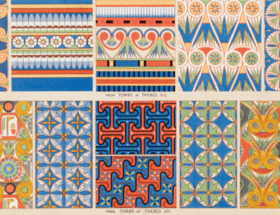By Pauline Weston Thomas for Fashion-Era.com
- Ancient Greek Dress
- Grecian Clothing
- Line Drawing Pattern - How to Make a Chiton
- Garment Fabrics For Chitons
- Doric Chiton
- Ionic Chiton
- Making A Greek Chiton
- The Greek Cloak, Chlamys or Himation
- Rustic Greek Dresses
- Ancient Greek Cloak, Chlamys or Himation
- Ancient Greece - Hairstyles for Women
- Greek Battle Dress
- Greek Timeline
Ancient Greek Dress
Although we think of Greece today as a relatively small country in the east of Europe, it was at one time the 'it' place of its day. It was a country of eminent thinkers and put Greece at the forefront of civilized thought and argument.
Manners and costume also helped create a Greek culture that gave additional structure to one of the greatest civilisations the earth has seen.
Consequently Greece has influenced every other nation that has risen to power since. The ideas, philosophies and writings left behind by the Greeks and the resultant archaeological finds from old ruins have created a good source of Greek era material and especially of costume.
Greek Clothing
Pictorial evidence has enabled us to have a very clear idea of Ancient Greek dress. The fashion history of ancient Greece has been carefully illustrated on vases, pots and in statue form.
These two images above are representations of ancient Greek clothing found by archaeologists.
One common factor of the styles of all early clothes is that they are made from uncomplicated basic shapes which rely on girdles, belts and brooches, clasp or pins to create shape and form around the human body.
Grecian clothes were little more than artfully arranged pieces of cloth, pinned and tucked into position as shown here.
Their elegance is derived from the careful arrangement of folds and complex arrangements of girdles, strapping or belts. Simple borders fall into interesting patterns when arranged as a long chiton robe.
Embroidered patterns such as checks and floral forms were used to embellish the fabric edges to create border effects. The most famous Greek pattern is the Greek key/fret pattern shown here.
Other patterns such as the acanthus were also a typical Greek motif.
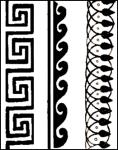
Line Drawing Pattern - How to Make a Chiton
Making A Greek Chiton
Both men and women wore the tunic or Greek chiton and it was simply an arrangement of folded and wrapped fabric as shown above and left.
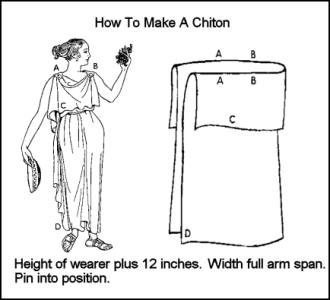
Women wore a floor length dress called a Greek chiton. In early times the Doric chiton was made from fabric which was the height of the wearer, plus 12 inches. The width was that of the full open arm span. The fabric was folded as shown in the chiton pattern picture shown right.
A is pinned to A and B is pinned to B. The open sides are wrapped around each other and a girdle tied at the waistline with the loose fabric of C at the same level. The gap between B and the side fold will drape when in fabric and become the second armhole.
If you don't want to go to the trouble of making your own, then here where you can hire a ready made Greek dress.
Men wore a short knee length Greek chiton mostly for everyday clothing, although there were times when they wore it long as did the Charioteer of Delphi in 475 BC.
Men frequently pinned their chiton on the left shoulder leaving a bare right shoulder. Or, they wore it in much the same two shoulder pinned manner as the woman show right.
You are reading an article about Ancient Greek dress by Pauline Weston Thomas at www.fashion-era.com ©
Garment Fabrics For Chiton Clothing
Doric Chiton
The Doric chiton was made from wool
Cloth was so valuable it was not cut in earlier eras, but in later times the chiton was constructed from two pieces of cloth. The earlier Greek Doric Chiton above was made of wool and simply folded around the body. In time they evolved into the Ionic chiton, which was made of linen and even silk.
Ionic Chiton
The Ionic chiton was made from linen or silk.
The advantage of using linen to make the Ionic chiton was that it was much more flexible, the result was that it hung in fine pleats of diaphanous crepon. Delicate muslin was also used.
With better materials came more sophistication, and more scope for the Greek fashion elite of the day, for example to create sleeves. As a result, Ionic chitons used more material and were fitted with fibulae on the shoulders. The Ionic Chiton attracted more accessories from the Greek fashion forward of those days, in particular they added brooches to confer wealth and status.
From a costume history concept of fashion repeating itself, the fine pleated look of the Ionic chiton was revived by the Edwardian fashion designer Fortuny who created Delphos tea gowns. Women adored Fortuny gowns because not only were they very relaxed and comfortable, but also showed off their feminine attributes.
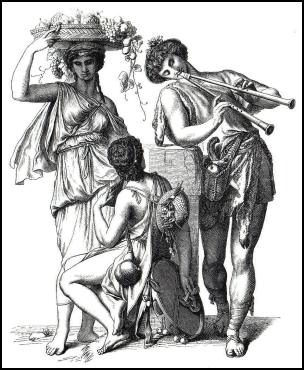
Colours for Ancient Greek clothing were not just white or natural as was first thought. While paint had worn away from statue evidence, further investigation showed the women of ancient Greece wearing several colours such as yellow, red, purple, blue or green.
Men wore white or beige. Some fabrics were patterned.
The different arrangements of fabric created a variety of styles like these two shown above.
Rustic Greek Dresses
Rustic dress was a more relaxed shorter version like these Grecian folk shown left. The loose, relaxed, short Greek chiton was better suited to working in the fields and tendering to the livestock.
The Ancient Greek Cloak, Chlamys or Himation
The Ancient Greek cloak was a simple rectangle or square of cloth thrown around the shoulders and fastened mostly with a bronze pin.
The name for this particular short cloak mostly worn as a short military cloak by young men or horsemen was a Greek chlamys.

In colder weather the larger cloak was worn, this was called a Greek Himation.
The female cloak is called a Greek peplos and was worn over their chiton.
Initially Greeks used wool and linen fabrics, but as the society became more sophisticated they traded for silk goods and it was not so much fashion styles that set individuals apart as the differentiation by the luxury that silk fabrics offered.
Ancient Greece Hairstyles
Over the centuries hair dressing was important to create various complex updo hairstyles. Women used gold, silver hair pins, cone headdress and tiaras. Young girls used fresh flowers and ribbons. Only boys and women had long hair and men cut their hair once they became youths.
Plaiting, crimping and waving of female hair as well as decoration with pins, tiaras and bands is well illustrated in Greek imagery and is shown left.
Popular styles involved tying the hair up with a fabric scarf, adding ribbons or garlands when a young woman or wearing a 'Stephanie' metal head dress.
When making costumes for fancy dress parties always remember the golden rule of getting the hair and feet as near as the style worn to match a costume. Ancient Greeks mostly went barefoot although some wealthy people did wear sandals. Courtesans wore gilded sandals.
Greek Battle Dress
Greek warriors of battle wore tunics of leather with metal plaque reinforcements. 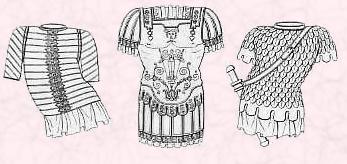 Helmets and leg protection called greaves added more skin coverage. Read and see more battle dress, helmets and shields on the Greek battle dress web page.
Helmets and leg protection called greaves added more skin coverage. Read and see more battle dress, helmets and shields on the Greek battle dress web page.
The metal battle dress itself was valuable since it had to be crafted by skilled metalworkers. 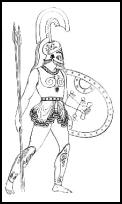 The higher the rank the better the dress armour and shield was crafted, and possibly, the more protective it became.
The higher the rank the better the dress armour and shield was crafted, and possibly, the more protective it became.
Some of the decorative metal elements paid homage to favourite Gods the Greeks thought would take care of them in battle and in the after life. One characteristic of the Greek helmet was that it almost totally enclosed the head and sometime had moveable sides, (but no visor) enabling the soldier to push back the face cover when at ease.
Horsehair crests made the helmet an impressive sight.
Greek light infantrymen wore double felt or leather tunics and leather greaves. All wore the Chlamys in battle (see above) as a cloak or as a left arm wrap for battle blows protection.
Greek male battle dress shares a similarity with Roman battle dress.
Greek Timeline
Original boundaries have changed in the past 2000 years so that famous Greek cities such as the incredible remains of the city of Ephesus are now part of Turkey.
Greece has a long history, but the Greece of the ancient world on this page, was declining by the time the Academy at Athens closed in 529AD.
529 AD is considered to be the start of the middle ages and the end of antiquity. It was also the end of Hellenistic Greece as the Ottoman empire spread far and wide invading lands east and west.
The earliest Greeks of importance began with the Pre-Socratic philosophers such as Thales and Pythagoras. After came Socrates then Plato and later Aristotle, each teaching the former. The Academy at Athens had existed for 9 centuries since the days of Plato.
After Alexander the Great came Hipparchos, Cicero, Lucretius, Ovid, Seneca, Pliny, Galen and Ptolemy. Each Greek made his mark on western philosophy and science and many of the words related to ethics and medicine in use today are derived from the teachings of these men. The world owes a great deal to one of the most sophisticated early civilised societies on earth at that time.
You have been reading an article on Ancient Greek dress by Pauline Weston Thomas at www.fashion-era.com ©
Page added 14 October 2008 Ref: P700
